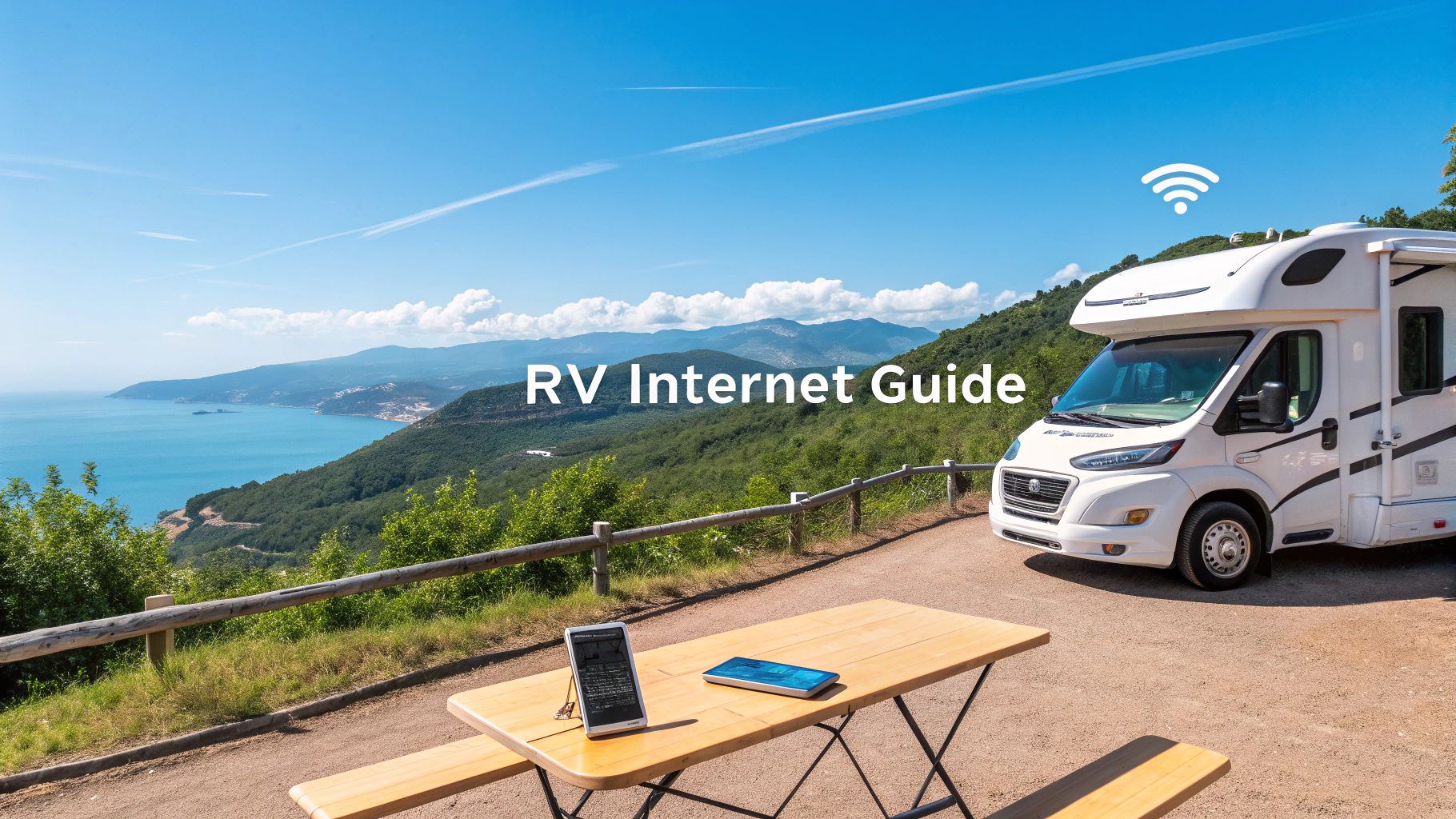

· Por James
Finding the Best RV Internet Providers for Your Rig
Picking the right RV internet provider isn't about chasing the fastest speeds. It's about finding what actually works for your travel style. The big three are satellite (like Starlink, which is great for remote areas), cellular (from folks like Verizon and T-Mobile for general travel), and good old public Wi-Fi as a backup.
The reality is, no single provider is perfect for every RVer. Your best bet is always a balancing act between coverage, cost, and what you actually need to do online.
How to Choose Your RV Internet Provider
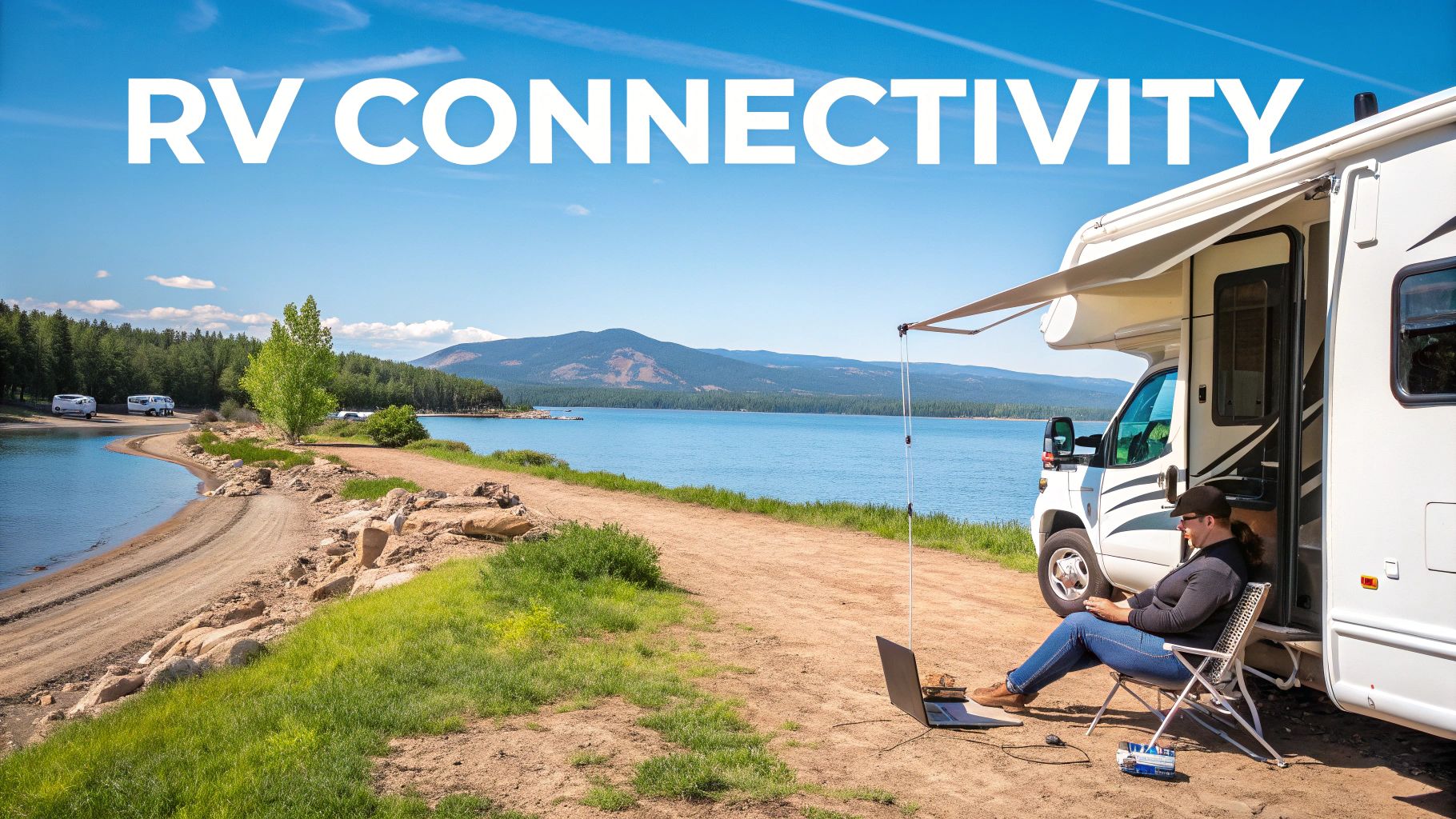
It can feel a little overwhelming with all the options out there, but you can simplify it by breaking it down. The decision really comes down to three things: where you go, what you do online, and how much you want to spend. The main headache for RVers is dealing with the trade-offs between having service everywhere, getting reliable speeds, and keeping monthly costs from getting out of hand.
This push for on-the-go connectivity is a huge deal for the telecom industry. In the US alone, the Internet Service Provider market is expected to reach $168.5 billion in 2025, and a big chunk of that is driven by people like us who need a solid connection wherever we park.
Comparing Your Primary Options
To get your bearings, it helps to look at your main choices from a high level. Each one serves a different kind of RVer, from the weekend warrior hitting local state parks to the full-time digital nomad working from the backcountry. This will help you figure out which category you fall into.
For a deeper dive into everything you should weigh, check out our complete guide on building a reliable https://swiftnetwifi.com/blogs/news/internet-for-rv-living. It gets into all the nitty-gritty details.
Quick Comparison of Top RV Internet Options
The table below gives you a quick snapshot of the main solutions. Think of it as a starting point to see where you might fit.
| Provider Type | Best For | Typical Speed | Primary Limitation |
|---|---|---|---|
| Satellite | Remote, off-grid locations with no cell service | 50-150+ Mbps | High upfront cost & needs a clear view of the sky |
| Cellular | Most travel near towns and major routes | 25-100 Mbps | Depends on cell tower location & potential data caps |
| Public Wi-Fi | Casual browsing in campgrounds or cafes | 5-25 Mbps | Unreliable speeds & major security risks |
After years on the road, I've learned that having a backup plan is non-negotiable.
Key Takeaway: The smartest strategy is almost always redundancy. Combining a primary service like cellular or satellite with the ability to hop on public Wi-Fi gives you the most flexibility. It means you’re ready for just about any situation you roll into.
When you're making your final choice, many of the same rules apply as when you're picking internet for a house. For more on the fundamentals, it's worth reading up on what to look for in an internet provider.
Satellite Internet for True Off-Grid Connectivity
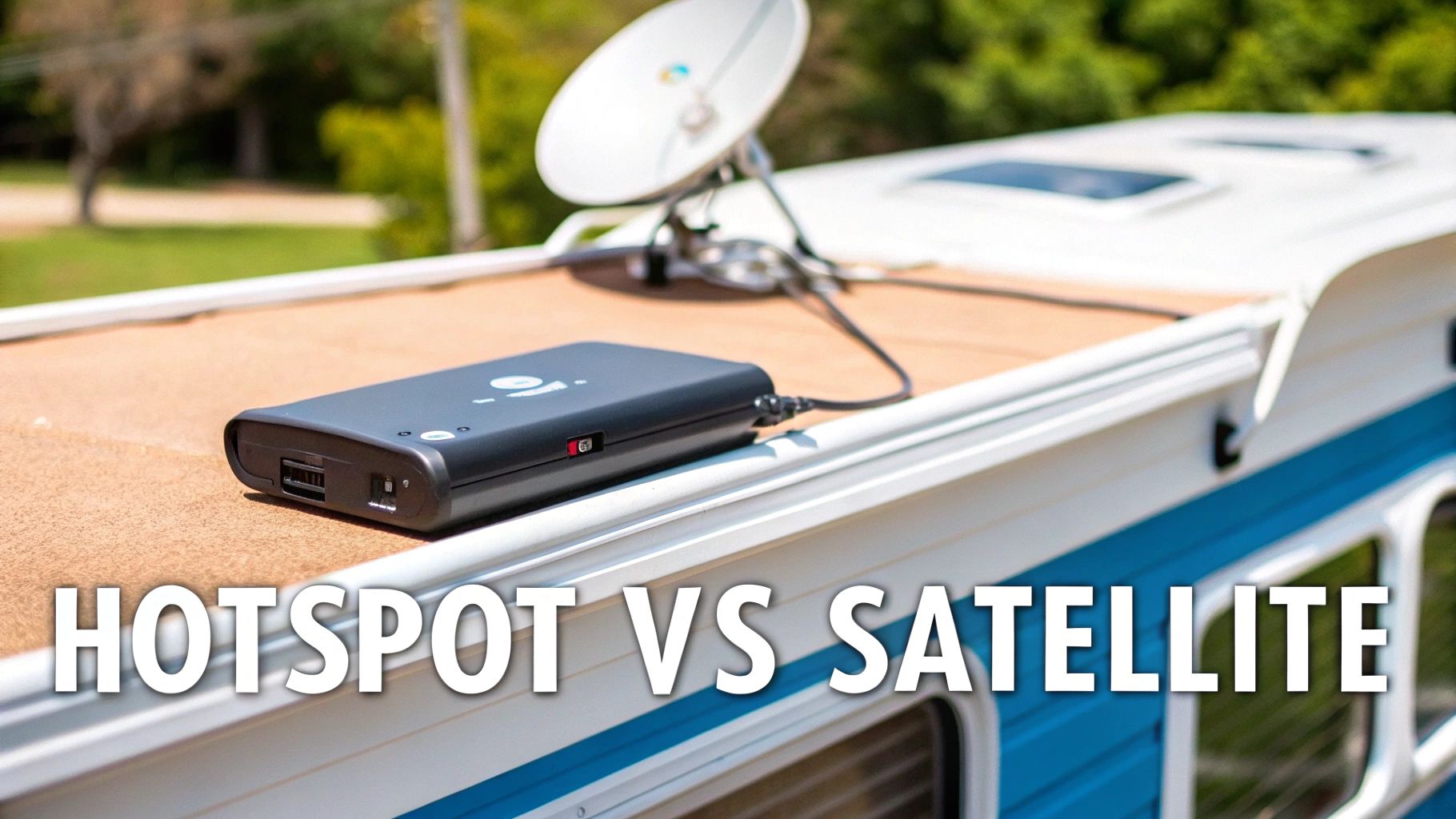
When your travel plans take you far beyond the last cell tower, satellite internet stops being a luxury and starts feeling like a necessity. For RVers who truly want to unplug from the grid without completely losing their digital lifeline, providers like Starlink offer an incredible solution. This tech bypasses all the ground-based infrastructure, beaming high-speed internet right from space to your rig.
This is what truly sets satellite apart from every other RV internet provider. It’s built for the most remote adventures imaginable—think deep in a national forest, a quiet desert landscape, or a hidden mountain hideaway where cell signals are just a distant memory. The ability to work, stream, or just stay in touch from these kinds of places is a total game-changer for many travelers.
Understanding Starlink Hardware and Plans
At the heart of the Starlink system is its satellite dish, which most users affectionately call "Dishy," and its router. The standard hardware is made for stationary use, which means you’ll set it up each time you park your RV. The process is pretty simple, but it does mean you have to find a good spot for the dish with a wide-open view of the sky.
Starlink has a couple of different service tiers that are perfect for nomads. The main options for RVers are:
- Starlink Roam: This is the plan most RVers gravitate toward. It lets you pause and un-pause your service month-to-month, giving you awesome flexibility for seasonal travel or occasional trips.
- Mobile Priority: This one is geared toward people who need guaranteed bandwidth for critical tasks. It costs more, but you get priority access on the network. It's also the plan you'll need for in-motion use if you have the flat-mounted hardware.
For a deeper dive into these plans, check out our guide on the top satellite internet for RV options in 2025, where we break down the latest offerings. This corner of the market is absolutely exploding; the satellite internet industry is expected to reach USD 12.61 billion in 2025. That growth is mostly thanks to new low Earth orbit (LEO) constellations that provide faster, more responsive service than ever before. You can get more details on these trends by reading the full industry report on satellite internet.
The biggest selling point for satellite is its massive coverage footprint. Where every other provider gives up, satellite internet delivers. It brings reliable connectivity to places that used to be digital dead zones, making it an essential tool for serious off-grid explorers and remote workers.
The Practical Downsides to Consider
As impressive as it is, satellite internet isn't without its own set of challenges. The biggest headache is its absolute need for an unobstructed view of the sky. A handful of trees or a narrow canyon wall can easily block the signal, turning your expensive gear into a useless paperweight.
Power consumption is another major factor. The Starlink dish is a thirsty piece of equipment, typically drawing between 50-75 watts. This can put a real strain on your RV’s battery bank, often demanding a pretty robust solar setup or frequent generator runs to keep it online.
Finally, you have to talk about the upfront cost. The hardware investment is significantly higher than any cellular-based option. If you're an RVer on a tight budget or someone who sticks to areas with decent cell service, the high price of admission might be tough to justify.
Cellular Internet: The Workhorse for Most RVers
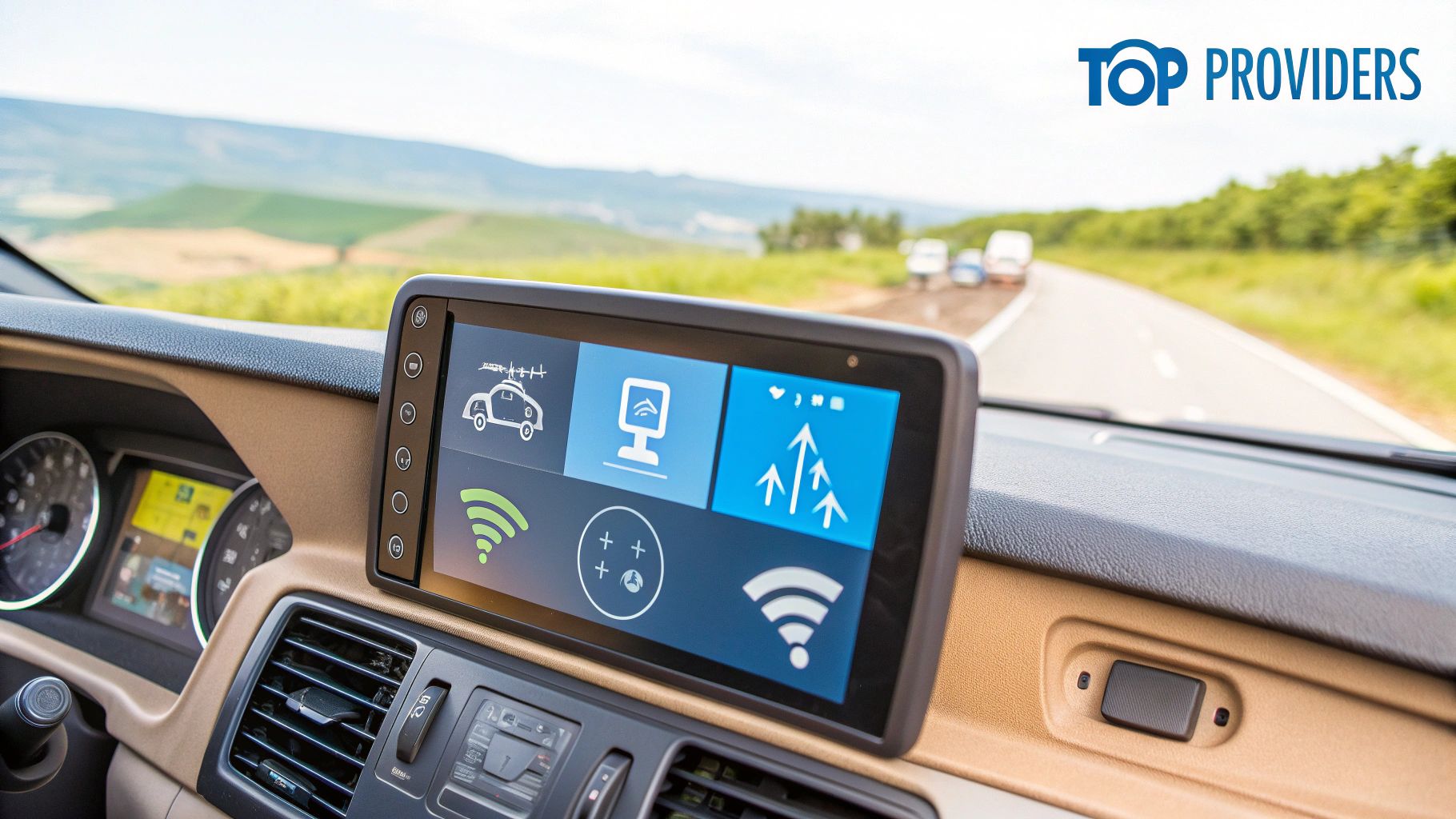
For the vast majority of us hitting the road, cellular data is the backbone of our internet setup. It just works. Cellular offers a fantastic blend of widespread coverage, decent cost, and pure simplicity that other options, like satellite, often can't touch. If you're like me and your travels generally keep you near towns and major highways, a good cellular plan from Verizon, T-Mobile, or AT&T is going to be your most reliable friend.
We're all familiar with this technology—it's the same network our phones use. But the real trick is to think beyond just using your phone's hotspot. To get serious about RV internet, you'll want a dedicated device and a data plan built for it. This move unlocks much higher data allowances and the kind of steady performance you need for everything from a surprise Zoom call to a rainy-day movie marathon.
The demand for this kind of on-the-go connectivity is absolutely booming. In fact, global internet service revenue is expected to climb to USD 567.3 billion in 2025. North America is a huge part of that growth, thanks to our solid infrastructure and our never-ending need for mobile data. For us RVers, this is great news; it means providers will keep getting better. You can dig into the numbers yourself in the latest internet service market report.
Navigating Plans and Policies
Alright, let's get into the nitty-gritty of choosing a plan. You have to look past the marketing hype and read the fine print. The best bets are usually the "Home Internet" or "Fixed Wireless Access" (FWA) plans from the major carriers. Now, these are technically meant for a fixed address, but countless RVers (myself included) use them on the road with great success.
It’s not always plug-and-play, though. You need to understand the three big gotchas that can affect your connection:
- Data Deprioritization: This isn't a hard "off" switch. After you've used a set amount of data, say 100GB, the carrier might slow you down a bit, but only when the local tower is congested.
- Throttling: This one is a bigger deal. Some cheaper or older plans have hard speed limits or will slow you to a crawl after you hit your data limit. You have to read the terms to avoid these.
- Network Management: This is the catch-all term for how carriers prioritize traffic. The key takeaway? Plans designed for dedicated routers and hotspots almost always get better treatment on the network than your phone's little hotspot does.
For us RVers, the whole 5G vs. 4G LTE thing isn't just about speed—it's about reliability. Sure, 5G is blazing fast when you can find it in a city, but a provider’s sprawling 4G LTE network is the real MVP. It’s the safety net that keeps you online in those out-of-the-way campgrounds and small towns.
Boosting Your Signal with the Right Hardware
Your internet experience is only as good as the gear you're using. A simple mobile hotspot is a decent starting point, but upgrading your hardware can make a world of difference, especially when you're parked in a spot with fringe service.
A cellular router is a major league step up. These devices are built for a more permanent install in your rig and come with game-changing features, like Ethernet ports for a hard-wired connection and, most importantly, ports for external antennas.
This is the killer combo: pairing a quality router with a roof-mounted external cellular antenna. This setup can grab a much stronger, cleaner signal than any small device stuck inside your metal-and-fiberglass box ever could. It dramatically boosts both your speeds and your connection's stability. If you're building a truly dependable mobile office, this combination is non-negotiable.
Comparing Providers on Speed, Cost, and Coverage
When it's time to pick an internet provider for your RV, you have to look past the flashy marketing and get down to what really matters on the road. Let's put the top contenders head-to-head on the big three: speed, real-world costs, and where you can actually get a signal.
The main players in the game for serious RV connectivity are Starlink Roam, Verizon Home Internet, and T-Mobile Home Internet. Each one is built for a different kind of RVer. Understanding their unique pros and cons is the only way to make sure you don't throw your money away on a service that doesn't fit your travel style.
RV Internet Provider Feature and Cost Breakdown
To make a smart decision, we need to line these services up and see how they stack up across the metrics that count. The table below is a detailed comparison of the leading RV internet solutions, evaluating them on key metrics that matter most to travelers. It breaks down everything from what you'll pay upfront to the data rules that can make or break your trip.
| Provider | Hardware Cost | Monthly Price | Typical Speed | Data Limits | Coverage Footprint |
|---|---|---|---|---|---|
| Starlink Roam | $599+ | $150/mo | 50-150 Mbps | Unlimited | Global (with clear sky view) |
| Verizon Home | $0-$399 | $35-$60/mo | 50-300 Mbps | Unlimited | Strongest 5G network |
| T-Mobile Home | $0 | $50-$60/mo | 40-180 Mbps | Unlimited | Widest 5G coverage |
These numbers give us a great starting point, but they don't paint the full picture. You have to think about what those speeds actually mean for what you do online.
Before we get into the nitty-gritty, this chart shows the typical internet speed you'll need for common online activities in your RV.
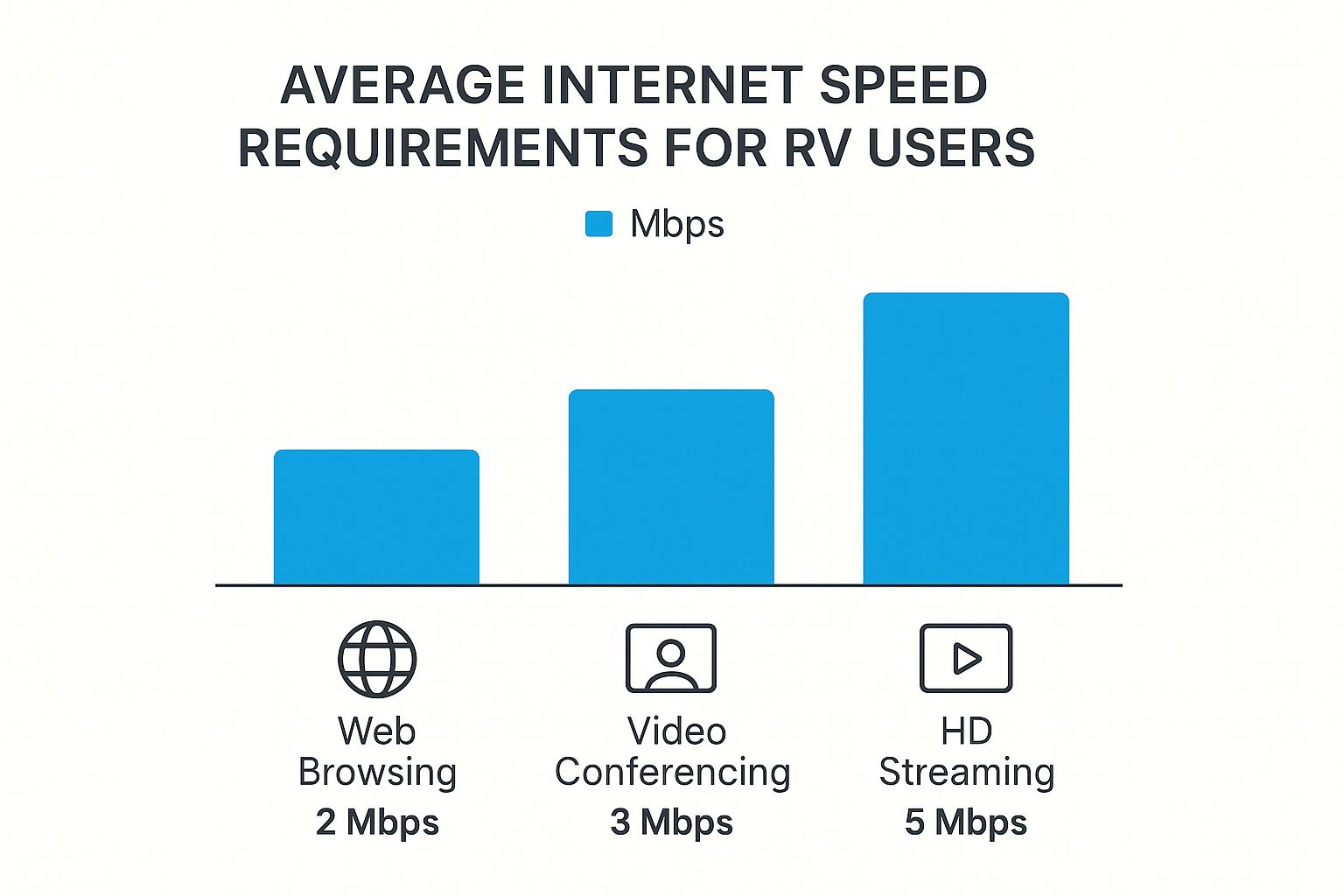
As you can see, even a humble 5 Mbps connection can handle HD streaming just fine. That means all three of these providers will easily cover you for movie nights and most remote work tasks.
Contextual Analysis and Recommendations
Starlink's steep upfront hardware cost and monthly fee jump out immediately. But for digital nomads who work from truly remote, off-grid locations, its value is hard to beat. If your paycheck depends on having a connection far from any cell tower, that $150 monthly fee starts to look like a smart business expense for its "works anywhere" reliability.
On the flip side, Verizon and T-Mobile offer incredible value for RVers who stick to towns, cities, and popular campgrounds. Their "Home Internet" plans deliver unlimited data for a fraction of what satellite costs. T-Mobile usually gets the nod for having a slightly larger 5G map, while Verizon often earns praise for its rock-solid network and faster peak speeds in populated areas.
Key Insight: Your decision should hinge on where you spend the majority of your time. If you’re a weekend warrior or someone who stays on established routes, a cellular plan is almost always the more practical and affordable pick. Only serious off-grid explorers and remote workers who absolutely cannot risk losing signal should make the leap to satellite.
Ultimately, the best RV internet provider is the one that balances performance with your personal budget and travel habits. For those who love online gaming, where low latency is critical, the decision gets even more layered. You can learn more in our guide on the best internet for rural gaming, which dives into getting a stable connection even when you're way out there.
Matching Your Internet Setup to Your Travel Style
Tech specs and data sheets are great, but they don't tell the whole story. The best way to actually pick an RV internet provider is to match your gear to how you really travel. Are you a weekend camper sticking to state parks, or a full-time digital nomad whose job depends on a solid connection?
Let's move past the numbers and look at what works in the real world. By figuring out which type of RVer you are, you can see which primary and backup solutions will actually have your back out there. It’s about building a system that won’t let you down when you need it most.
The Weekend Warrior
This is the classic camper. You love hitting established campgrounds and state parks for short getaways, mostly on weekends or for a week of vacation. You're not trying to run a business from your rig, but you still want to stream a movie, check emails, find your next stop, and keep the family happy online. For you, it's all about convenience and a good price, not mission-critical uptime.
- Primary Solution: Cellular Home Internet. A plan from a provider like T-Mobile or Verizon hits the sweet spot. You get good speeds, unlimited data, and a low monthly bill. Their routers are usually just plug-and-play, so setting up at a new campsite is a piece of cake.
- Backup Solution: Campground Wi-Fi. When you find yourself in a cellular dead zone (it happens!), the campground’s Wi-Fi is a decent fallback. Sure, it might be slow, but it's usually free and gets the job done for simple things.
The Digital Nomad
Your entire livelihood is tied to a fast, stable internet connection. You're hopping on video calls, uploading hefty files, and can't afford to miss deadlines. While you often stick to popular, well-connected areas, you might also want to explore more remote spots. For you, even one day of bad internet can mean a major headache at work.
- Primary Solution: Cellular Router with an External Antenna. This is your workhorse. Pairing a robust cellular plan with a quality roof-mounted antenna is key to pulling in the strongest possible signal. It's the setup that delivers the reliable performance your job demands.
- Backup Solution: Starlink Roam. For those times you find the perfect campsite but it has zero cell service, Starlink is your get-out-of-jail-free card. You won't need it at every stop, but knowing it's there means you can travel anywhere without stressing about missing that important meeting.
Choosing the right RV internet is really about building a system. If you're working remotely, relying on just one internet source is a recipe for stress. A dual-threat setup—a top-tier cellular plan backed up by satellite—is what gives you true peace of mind on the road.
The Off-Grid Explorer
You're an adventurer at heart. Your main goal is to get as far from civilization as you can, exploring national forests, BLM land, and rugged coastlines where cell towers are just a rumor. Connectivity for you is more about safety and the occasional check-in, but when you do need it, it absolutely has to work.
- Primary Solution: Starlink Roam. This is non-negotiable for true off-grid travel. Satellite is the only technology that can deliver high-speed internet in the wild places you love to go. Think of it as your lifeline to the modern world.
- Backup Solution: A Cell Signal Booster. On travel days or when you're on the absolute fringe of service, a booster can be a lifesaver. It can grab a faint, unusable signal and amplify it just enough to make a call, send a text, or get a basic data connection going.
Answering Your Top RV Internet Questions
As you dive into the world of RV internet, a lot of questions pop up. It's totally normal. As you're piecing together your connectivity plan, it's easy to get stuck on the day-to-day practicalities—how different systems actually work, what to expect on the road, and what you really need. Let's tackle some of the most common questions to clear things up and get you on the right track.
One of the first things almost every new RVer asks is about just using their phone's hotspot. While it's a tempting shortcut, relying on it full-time is a recipe for frustration.
Can I Just Use My Phone Hotspot?
Using your phone's hotspot sounds great in theory, but it comes with some serious limitations that can leave you high and dry. Most smartphone plans have surprisingly strict data caps for hotspotting, often as low as 15-30GB per month. Once you blow past that, your speeds are usually throttled down to a crawl, making video calls or streaming a non-starter.
Even worse, carriers often deprioritize hotspot traffic. This means that even with a full signal, your speeds can be painfully slow because the network is giving preference to phone users and dedicated internet plans. If you need internet you can count on, a dedicated cellular router or hotspot is the only way to go.
Think of your phone's hotspot as a great backup for a quick email check or an emergency. But treating it as your primary internet source will only lead to frustrating data caps and unreliable speeds right when you need a connection the most.
When Do I Need a Cellular Signal Booster?
A cellular signal booster is an incredible tool, but it's not a magic wand. It can’t create a signal where one doesn't exist. Instead, it grabs a weak but usable signal from outside, gives it a massive power-up, and then rebroadcasts it inside your RV. This is a game-changer when you have one or two bars of service outside but practically nothing inside your rig.
You need a booster when:
- You consistently find yourself in fringe areas with weak, but still present, cell signals.
- Your RV’s construction (like aluminum siding or heavy insulation) is basically a Faraday cage, blocking signals from getting inside.
- You're looking to improve call quality and basic data stability, not necessarily chase lightning-fast download speeds.
A booster can absolutely turn an unusable signal into a stable one. But if there’s no signal to begin with, it won't have anything to amplify.
How Do I Stay Connected While Driving?
Staying online while the wheels are turning is a huge deal for many RVers, especially families trying to keep kids entertained or a passenger who needs to work. Your options here really depend on your hardware and service plan.
Standard satellite systems, like the regular Starlink Roam dish, are not built for in-motion use. They have to be stowed away while you're driving. To get satellite on the move, you need to upgrade to specialized, flat-mounted hardware and a pricier Mobile Priority plan.
For most people, cellular is the go-to solution for on-the-go connectivity. A dedicated cellular router creates a steady and reliable Wi-Fi signal for everyone in the RV as you travel. It automatically jumps between cell towers, keeping your connection stable as long as you're in a service area. It's hands-down the most practical choice for in-motion internet.
Ready to stop worrying about your connection and start enjoying your travels? SwiftNet Wifi delivers high-speed, reliable 5G internet designed for RVers and rural residents. Find the perfect plan for your adventures.

